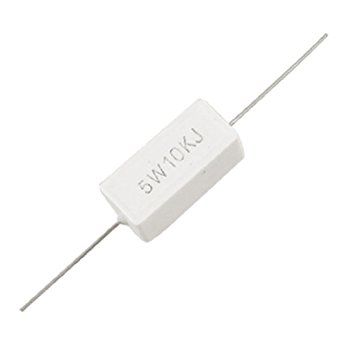مقاومت آجری (Brick resistor) ساختار ، عملکرد و تِست (برق _ الکترونیک)
پژوهشگر و نویسنده: دکتر ( افشین رشید )
نکته : مقاومت آجری یک عنصر الکتریکی دو پایه است که مطابق قانون اهم هنگامی که جریان الکتریکی از آن عبور کند بین پایههایش اختلاف ولتاژ ایجاد میشود و به منظور کم نمودن ولتاژ و جریان مورد استفاده قرار می گیرد . واحد اندازه گیری توانِ مقاومت آجری اُهم است .
این قطعه مصرف بسیاری در الکترونیک دارد.جنس مقاومت های آجری معمولاً از کرم نیکل است و معمولاً دارای یک روکش گچی یا آجری می باشند و به همین دلیل به مقاومتهای گچی یا آجری نیز معروف هستند . ظرفیت اُهمی و توان این مقاومتها بصورت عدد بر روی آنها چاپ می شود .شکل خاص محفظه مقاومت های آجری این امکان را فراهم می آورد که برای خنک کردن آنها بتوان آنها را بر روی ورقه فلزی خنک کننده (Heat sink) قرار داد .
مقاومت های آجری معمولاً در دو نوع قدرتی و دقیق ساخته می شوند . نوع قدرتی در محدوده توان های 2 وات تا 250 وات ساخته می شود و می تواند جریان های زیاد را از خود عبور دهد . نوع دقیق نیز در محدوده توان های 0.25 وات تا 2 وات ساخته می شود و دارای تلرانس پایینی می باشد اما نمی تواند جریان های زیاد را از خود عبور دهد .
معمولا اندازه فیزیکی مقاومت های آجری که در جریان های زیاد مورد استفاده قرار می گیرند بزرگتر از اندازه فیزیکی مقاومت های آجری معمولی است که برای کارهای دقیق و جریان پایین به کار می روند . مقاومت های سیمی قدرتی معمولا به شکل یک محفظه سیمان مانند که دارای سطح مقطع مربع یا مستطیل شکل است ساخته می شوند و به مقاومت های آجری معروفند .
نحوه تست مقاومت آجری
در هنگام تست با مولتی متر مقاومت پروب های مولتی متر در هر دوطرف به ما عدد یکسان نمایش میدهند که این نشانه سالم بودن مقاومت آجری میباشد. مثال عدد : 195- 195 در تست دوپایه مقاومت مهم یکسان بودن اعداد است. البته بهترین تست برای مقاومت آجری تعویض مقاومت مشکوک به عیب میباشد.
نویسنده: دکتر (افشین رشید )





